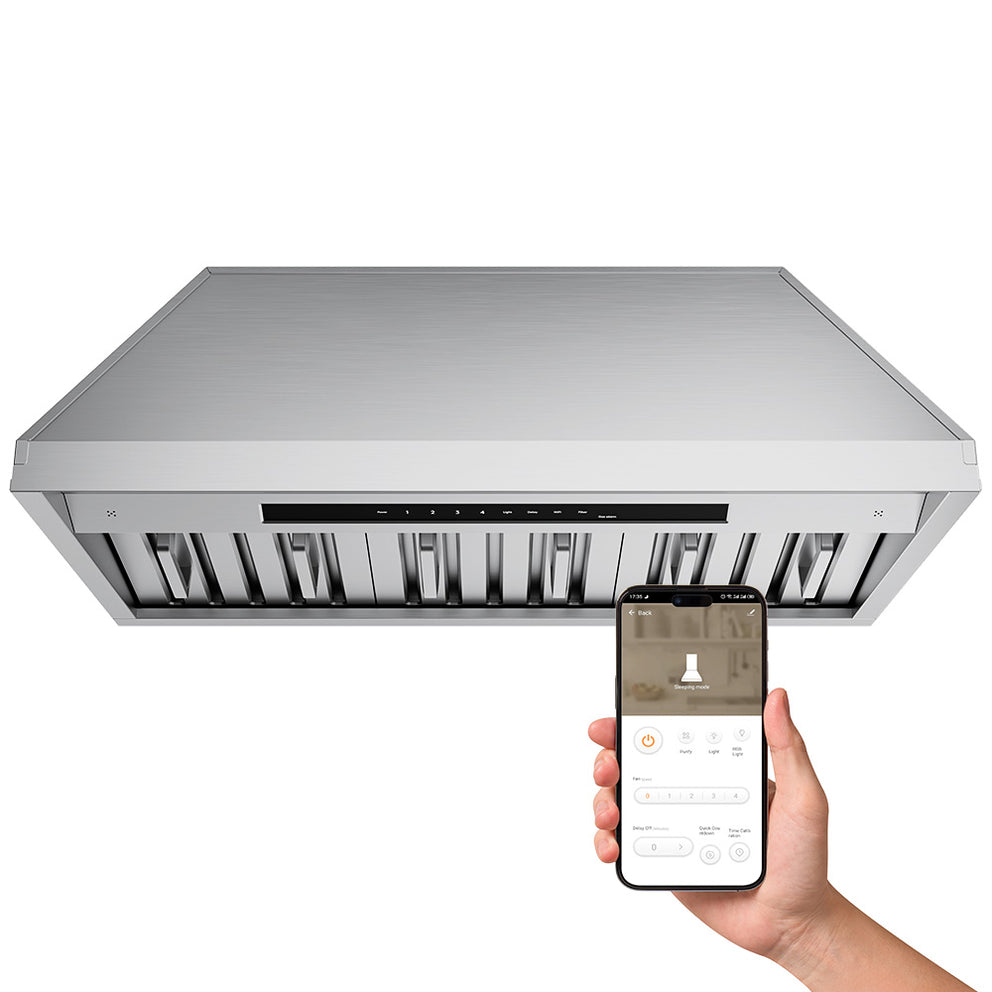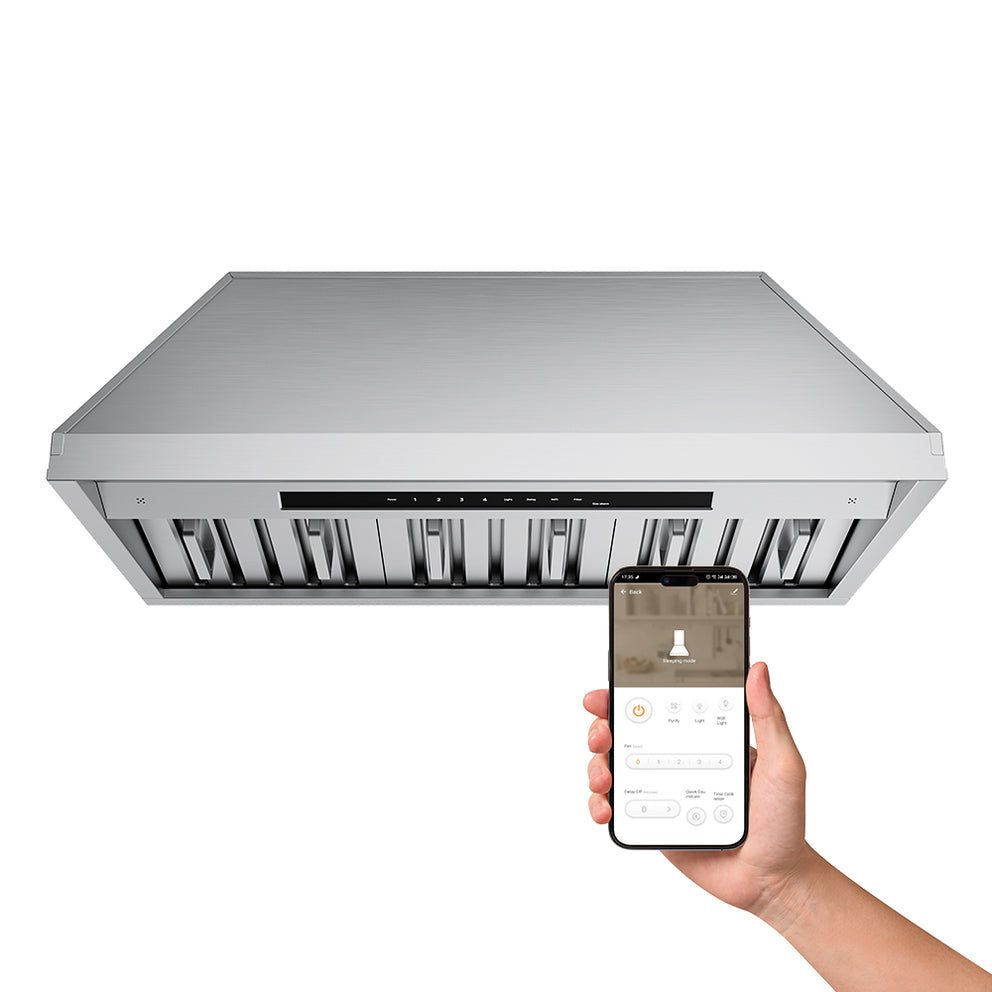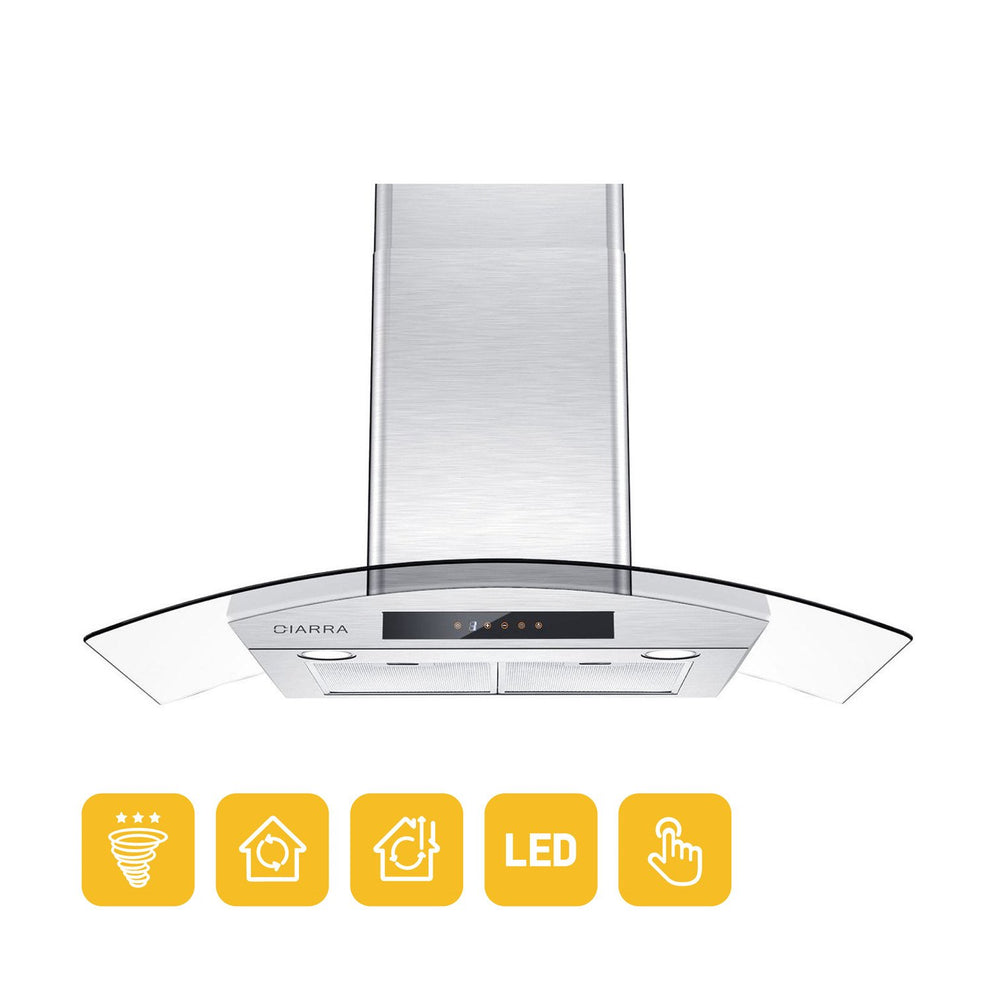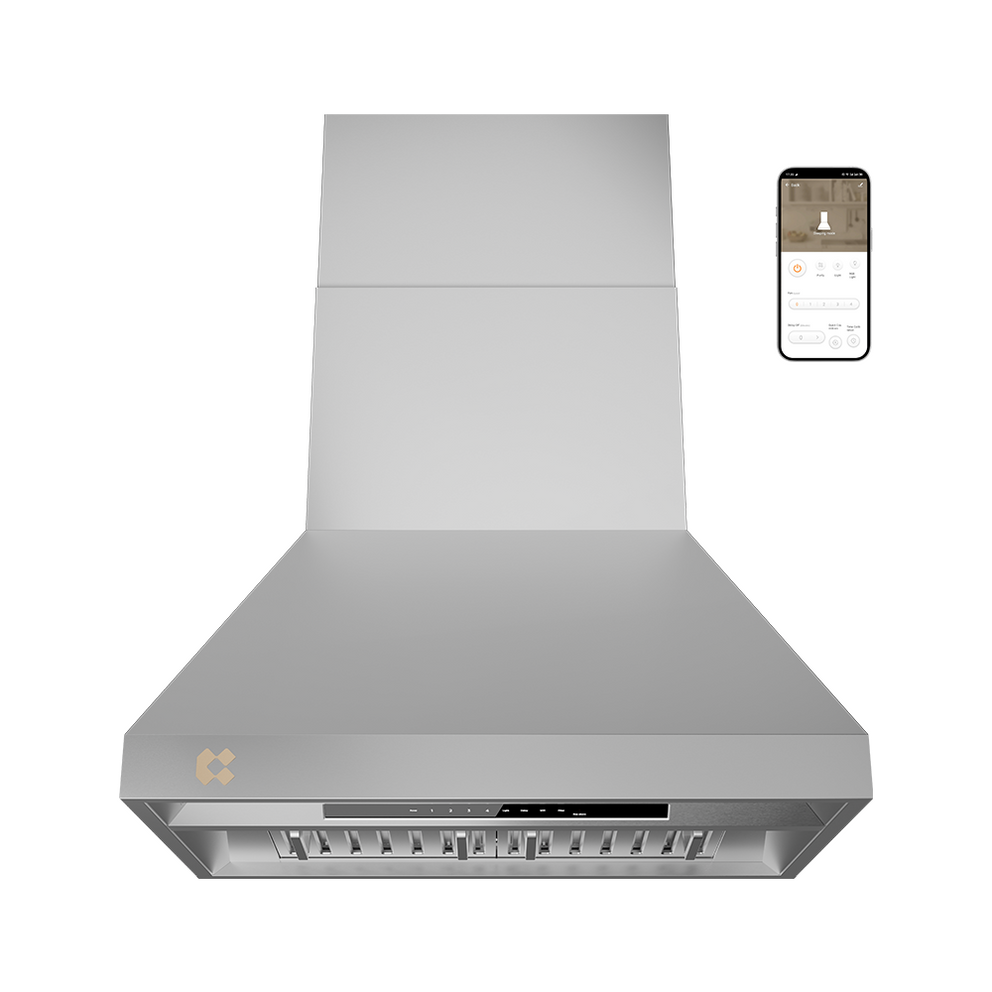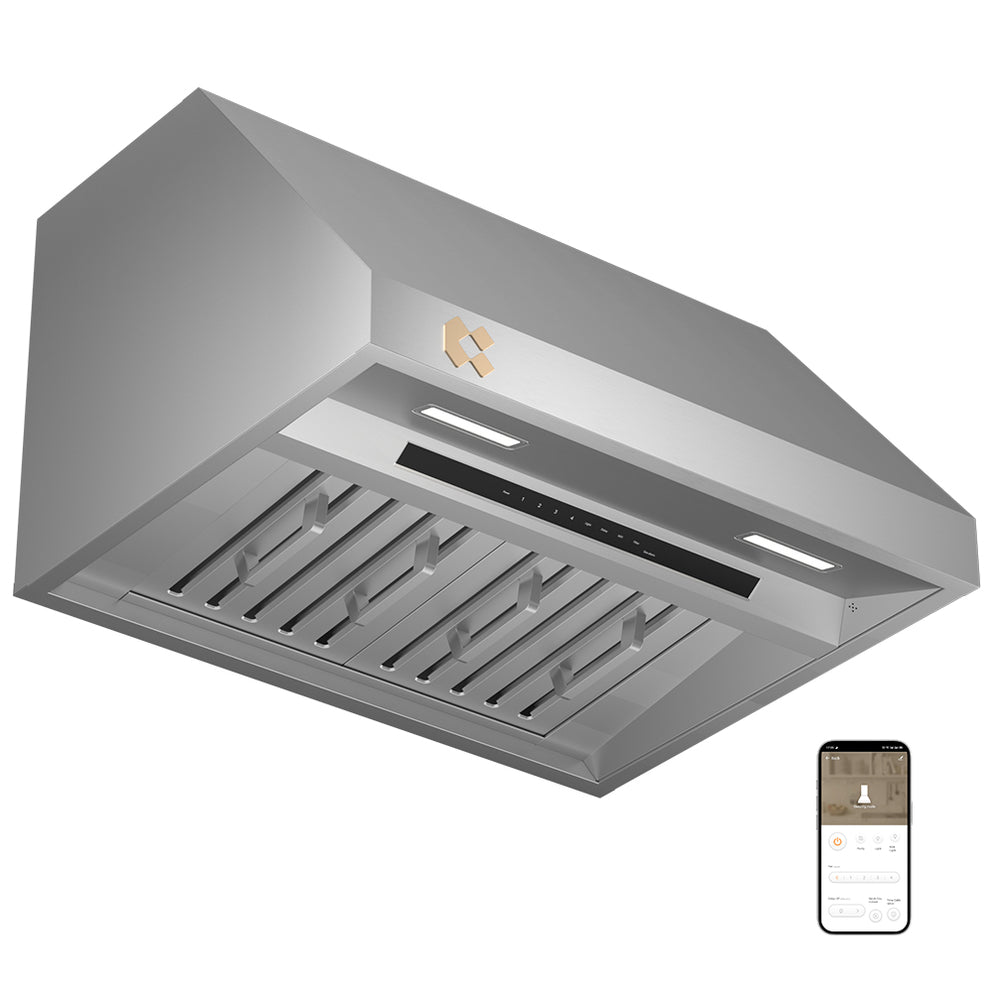Kitchen fires remain a leading cause of home accidents, with cooking equipment involved in nearly 50% of home fires, according to the NFPA. Gas stoves, in particular, are linked to many of these incidents due to high heat, grease, and open flames. To reduce these risks, many homeowners are turning to induction cooktops, which eliminate open flames and provide a safer, more controlled cooking environment.
Induction cooktops are gaining popularity for their safety, energy efficiency, and precise temperature control. Unlike gas stoves, they use magnetic fields to heat the pan directly, leaving the cooktop cool and reducing the risk of fire hazards. They also offer faster cooking times and are easier to clean.
If you're switching to an induction cooktop, it’s important to choose the right range hood. For smaller cooktops (24 inches), a 30-inch range hood should suffice, while larger 36-inch models require a 36-inch range hood with high CFM airflow (like CIARRA’s 900 CFM options) for optimal performance.
If you’re sticking with your gas stove, especially one that’s used frequently, it's even more critical to choose the right range hood. Gas stoves generate more heat and smoke than induction cooktops, which means you’ll need a more powerful range hood to keep your kitchen air clean.
- Smaller Gas Stoves: A 30-inch range hood should be sufficient for a standard gas stove, with at least 600–900 CFM for optimal smoke extraction.
- Larger Gas Stoves: If you use a 36-inch gas stove, especially for high-heat cooking like stir-frying or grilling, you’ll need a 36-inch range hood with a higher CFM, such as 900 CFM.
Why Choose CIARRA Professional Range Hoods?
1. Range Hood for Gas Stove
Gas stoves produce a significant amount of smoke and heat during cooking. Compared to induction cooktops, gas stoves generate stronger heat and more intense smoke, requiring a range hood with powerful suction and efficient smoke capture. CIARRA’s Professional Series range hoods are designed to meet these needs with the following benefits:
900 CFM Airflow: With up to 900 CFM of airflow, CIARRA range hoods effectively remove smoke from gas stoves, keeping the kitchen air fresh.
Powerful Smoke Extraction: Equipped with an advanced smoke filtration system, CIARRA range hoods capture and expel smoke quickly, making them especially suitable for high-heat gas stoves.
304 Stainless Steel Construction: Made with durable 304 stainless steel, CIARRA range hoods are heat-resistant and corrosion-resistant, designed to handle the high temperatures of kitchen environments.
Gas Leak Detection Safety: In addition to its powerful performance, CIARRA range hoods are equipped with gas leak detection technology. If a gas leak is detected, the range hood sends an immediate alert to your smartphone, ensuring the safety of your home and kitchen.

These features make CIARRA range hoods a perfect choice for dealing with the heavy smoke, high heat, and safety concerns produced by gas stoves.
This added safety feature makes the range hood not only effective but also a more secure choice for households using gas stoves.
2. Under Cabinet Vented Range Hood
Under-cabinet vented range hoods are a popular choice, typically installed below the cabinet. They expel smoke through external venting, ensuring that the kitchen air stays fresh, and are particularly suitable for kitchens with limited space. CIARRA’s under-cabinet vented range hoods offer the following advantages:
- External Venting: CIARRA’s under-cabinet models use external venting systems that effectively push smoke out of the kitchen, preventing it from re-entering the air.
- 304 Stainless Steel: The 304 stainless steel construction not only provides durability but also resists corrosion in high-heat environments, maintaining both function and aesthetic appeal.

Why 304 Stainless Steel?
- Durability: 304 stainless steel is the gold standard for kitchen appliances. It’s incredibly durable, heat-resistant, and will maintain its sleek look for years to come.
- Corrosion Resistance: Unlike cheaper metals like 201 stainless steel or aluminum, 304 stainless steel is highly resistant to rust, oxidation, and staining, making it perfect for the high-moisture, high-heat kitchen environment.
- Maintenance: 304 stainless steel is easy to clean and will not tarnish or develop permanent stains as easily as other materials.
304 Stainless Steel vs Other Materials
| Feature | 304 Stainless Steel | 201 Stainless Steel | Aluminum |
|---|---|---|---|
| Corrosion Resistance | Excellent (Highly resistant to rust and oxidation) | Fair (Less resistant to rust) | Poor (Can rust over time) |
| Heat Resistance | Very High (Can withstand high temperatures) | Moderate (Not suitable for high-heat environments) | Low (Deforms at high temperatures) |
| Durability | Extremely durable and long-lasting | Less durable, can be prone to scratches | Lightweight, but not durable |
| Maintenance | Easy to clean and maintain, resistant to staining | More difficult to clean, may stain | Requires frequent cleaning to prevent buildup |
| Appearance | Modern, sleek, and professional look | Less polished, more industrial | Dull, doesn’t match high-end designs |
| Cost | Higher cost due to premium quality | More affordable, but lower performance | Budget-friendly, but not ideal for longevity |
3. 900 CFM Range Hood
For kitchens that need efficient ventilation, especially when using gas stoves or cooking at high temperatures, a 900 CFM range hood is an ideal choice. CIARRA’s 900 CFM range hood offers powerful suction that quickly removes large amounts of smoke produced during cooking.
- Efficient Smoke Extraction: The 900 CFM airflow is perfect for handling heavy smoke generated by high-temperature cooking methods like stir-frying and deep-frying.
- High-Intensity Filters: CIARRA’s 900 CFM range hoods come with multi-layer filters that capture harmful particles from smoke, keeping the kitchen air fresh.
- Energy-Efficient: Despite the high airflow, CIARRA’s range hoods are energy-efficient, providing powerful smoke extraction while keeping energy consumption low.
4. 36 Inch Range Hood
CIARRA’s Professional Series also offers large-size range hoods, including the 36-inch model, ideal for medium to large kitchens. A 36-inch range hood provides a wider smoke extraction area, making it perfect for handling larger cooking tasks. These range hoods not only offer strong suction but also cover more kitchen space, ensuring that every corner of smoke is quickly expelled.

- Wide Extraction Area: The 36-inch design allows for more extensive coverage, making it perfect for large kitchens with multiple cooking zones.
- Powerful Suction: With a 900 CFM airflow, CIARRA’s 36-inch range hood efficiently extracts smoke from cooking activities like frying and simmering, keeping the kitchen air clean.
- Multiple Design Options: CIARRA offers various styles of 36-inch range hoods to suit different kitchen layouts, including both under-cabinet and wall-mounted designs.
Related: Top Rated Range Hoods: Ciarra Pro Range Hood
5. Multiple Sizes Available:
29-inch (Compact Fit):
Ideal for apartments, smaller kitchens, or compact cooking spaces.
30-inch (Standard Fit):
The most common size for U.S. cooktops fits seamlessly with most standard ranges.
36-inch (Professional Fit):
Designed for larger cooking surfaces, gas ranges, or gourmet kitchens where broader coverage and higher airflow are essential.
Whether you're replacing an existing unit or planning a full kitchen upgrade, Ciarra Pro offers the size and style flexibility to meet your space and ventilation needs — without compromising on performance or safety.
What is the Difference Between CIARRA’s Professional Series and Other Range Hoods on the Market?
CIARRA’s Professional Series range hoods stand out due to their advanced features, including the Plasma⁺ air purification system, which removes bacteria and odors, and high-efficiency motors providing up to 900 CFM airflow. Additionally, CIARRA range hoods are built with 304 stainless steel for durability and corrosion resistance, offering superior build quality compared to many competitors. Their energy-efficient design and quiet operation (under 65 decibels) also set them apart from other range hoods on the market.
How to Install Professional Range Hood
Installing a professional range hood can enhance your kitchen’s ventilation and safety. Here’s a general step-by-step guide on how to install a professional range hood:
1. Gather the Tools and Materials
You’ll need:
- Professional range hood
- Mounting brackets (usually included)
- Drill and drill bits
- Screwdriver
- Tape measure
- Level
- Ducting (if vented externally)
- Screws and fasteners
- Pencil for marking
- Stud finder (if applicable)
2. Prepare the Installation Location
Measure: Determine the appropriate height for your range hood. Typically, it should be installed between 24 to 30 inches above the cooktop, but refer to your model's manual for specific guidance.
Find the studs: Use a stud finder to locate the wall studs where you will attach the range hood. Mark their locations with a pencil.
3. Mount the Range Hood Brackets
Attach the mounting brackets to the wall according to the manufacturer's instructions. These brackets will support the weight of the range hood.
Ensure that the brackets are level before securing them with screws.
4. Install the Ductwork (for Ventilated Models)
If your range hood is ducted, you’ll need to install ducting to vent smoke and odors outside.
Measure and cut the ducting to the appropriate length to connect the range hood to the external vent.
Use clamps to secure the ducting to the range hood's exhaust port, ensuring a tight fit to prevent air leaks.
5. Attach the Range Hood
Lift the range hood into position, aligning it with the mounted brackets.
Secure the range hood to the brackets using screws provided by the manufacturer.
Double-check the alignment and ensure it’s level.
6. Connect the Electrical Wiring
If the range hood requires hardwiring (not just a plug), ensure the power is turned off before proceeding.
Follow the manufacturer’s wiring instructions to connect the range hood to the power supply. If you’re unsure, it’s best to hire a professional electrician.
7. Install the Filters and Finishing Touches
Insert the charcoal or grease filters into their designated slots, depending on the model.
Ensure that the controls, lights, and fan function properly.
Clean the range hood surface to remove any dust or debris from installation.
8. Test the System
Turn on the range hood and test all settings (fan speeds, lighting, etc.).
Check for proper airflow and ensure the fan is running quietly and efficiently.
For more detailed installation guides, please see: How to Install Professional Range Hood
How to Clean a Stainless Steel Range Hood
Cleaning your stainless steel range hood regularly helps maintain its appearance and functionality. Here's a step-by-step guide on how to clean a stainless steel range hood effectively:
1. Gather Cleaning Supplies
You will need:
- Mild dish soap or stainless steel cleaner
- Warm water
- Microfiber cloth or soft sponge
- Baking soda (optional)
- Vinegar (optional)
- Soft-bristled brush (for grease traps)
- Paper towels or dry microfiber cloth
2. Turn Off the Range Hood
Before cleaning, make sure the range hood is turned off and unplugged (if applicable). This ensures your safety while cleaning.
3. Clean the Exterior of the Range Hood
Mild Soap and Water: Mix warm water with a small amount of mild dish soap. Dampen a microfiber cloth with the soapy water and gently wipe down the stainless steel surface. Follow the grain of the steel to avoid scratches.
Stainless Steel Cleaner: If you want to restore the shine, use a dedicated stainless steel cleaner. Spray it on a cloth (not directly on the hood) and wipe with the grain. Avoid using abrasive scrubbers, as they can scratch the surface.
For Stubborn Spots: Apply a small amount of vinegar to a cloth and wipe away grease spots or water stains. Vinegar works well for removing finger marks and light tarnishing.
4. Clean the Filters
Remove the Filters: Most range hoods have metal mesh or baffle filters that trap grease. Remove the filters carefully, usually by pulling them out of the bottom or sides of the unit.
Wash with Soapy Water: Submerge the filters in warm water with mild dish soap and let them soak for 15–20 minutes to loosen grease. Use a soft brush to scrub away grease and debris.
For Grease Build-Up: For heavy grease build-up, you can sprinkle baking soda on the filters, add a small amount of water to make a paste, and scrub gently. This will help break down grease stains.
Rinse and Dry: After cleaning, rinse the filters thoroughly with warm water. Dry them with a clean cloth or paper towel before reinstalling them.
5. Clean the Fan and Vent
Fan Blades: If your range hood has visible fan blades, use a microfiber cloth or a soft brush to remove dust and grease. If the fan is built into the unit, clean the surrounding areas with a soft cloth.
Vent: Use a vacuum cleaner with a brush attachment to clean the vent area, or wipe it with a damp cloth to remove dust and grease. Be sure the vent is clear for proper airflow.
6. Polish the Stainless Steel (Optional)
To give your range hood a polished finish, apply a small amount of olive oil or baby oil to a microfiber cloth. Rub it gently on the stainless steel surface following the grain to restore its shine and provide a protective layer.
7. Final Wipe and Reassemble
After cleaning all components, wipe down the entire range hood with a dry microfiber cloth to remove any remaining water or cleaner residue. Reinstall the cleaned filters and ensure the range hood is properly reassembled.
Related: 5 Ways to Clean Stainless Steel Range Hood
What Type of Filters do CIARRA Professional Range Hoods Use, and How Often Should They Be Replaced?
CIARRA’s Professional Series range hoods use dishwasher-safe baffle filters, which are easy to clean and maintain. These filters should be cleaned every 1-2 months to ensure optimal performance. A helpful filter cleaning reminder will notify you on your phone when it's time to clean them.
For ducted models, no charcoal filters are required. However, if you prefer ductless operation (recirculating air), you can purchase a Plasma⁺ filter separately. The Plasma⁺ filter is long-lasting and doesn’t need to be replaced, making it a sustainable and eco-friendly choice for keeping your kitchen air fresh without constant maintenance.

How Do I Maintain the Performance of my CIARRA Professional Range Hood?
Proper maintenance is essential to ensure the optimal performance and longevity of your CIARRA Professional Range Hood. Follow these guidelines to keep your unit running smoothly:
1. Grease Filters Maintenance
Cleaning Frequency: Clean the grease filters frequently to ensure efficient operation.
Cleaning Method: The grease filters are dishwasher-safe and can be cleaned at high temperature. Avoid using detergent during cleaning to prevent damage.
Fire Risk: It’s crucial to follow the cleaning instructions properly. Failure to do so may pose a fire risk due to grease buildup.
2. Stainless Steel Cleaning
Do:
- Regularly clean the stainless steel surface with a cloth or rag soaked in warm water and mild soap or liquid dish detergent.
- You can also use a specialized stainless steel cleaner for a polished finish.
Don't:
- Avoid using steel wool or other abrasive scrapers to remove stubborn dirt.
- Never use harsh or abrasive cleansers, as they can scratch and damage the surface.
- Ensure that construction dust or residues do not reach the hood during renovations. Always cover the range hood if renovation work is being carried out nearby.
Cleaning Tip:
Be cautious when choosing cleaning products. Avoid cleaners with bleach, chloride, fluoride, iodide, bromide, or combustible products like acetone and alcohol, as these can damage the stainless steel or create a safety hazard.
3. Painted Finish Cleaning
Clean the painted surface with warm water and mild detergent only.
If discoloration occurs, you can use automotive polish to restore the finish. Do not use rough abrasive cleaners or porcelain cleaners, as they can damage the painted finish.
4. LED Lamp Maintenance
Turn Off Power: Before performing any cleaning or replacing parts, disconnect the range hood from the power supply to prevent electrical shock.
LED Lamp Replacement:
Remove the LED lamp by gently pushing the lamp holder out of the cabinet. You may need a screwdriver to pry it up around the edges.
Pull out the LED lamp and its wire, and then replace it with the appropriate model.
Test the Lamp: After replacement, ensure the light is properly installed and test the blower and light functions to ensure they operate correctly.
Common Issues and Troubleshooting for CIARRA Professional Range Hood
| Problem | Possible Cause | Solution |
|---|---|---|
| Extractor hood does not turn on | No electrical supply | Make sure the range hood is plugged into a powered outlet. Test the outlet with another device if not working. |
| My range hood has poor performance | Inadequate ventilation |
Ensure that the kitchen is sufficiently ventilated to allow entry of fresh air Optimal distance is 30"~36" above the cooktop for best extraction |
| The range hood and cooktop are too far away from each other | Remove the tape holding down the damper |
|
| The range hood and the cooktop are too far away from each other | Clean the grease filters or replace the grease filters |
|
| Check and make sure the tape holding down the damper flaps at the vent hole are removed before use | Replace new carbon filters |
|
| Grease filters clogged with grease build-up Carbon filters clogged with grease build-up Motor is running but no extraction |
Please contact CIARRA Customer Care Service |
|
|
My range hood is noisy |
Check inside the range hood for any loose debris and remove |
Please contact CIARRA Customer Care Service |
| If the noise is from the motor, please contact our Customer Care Service |
Please contact CIARRA Customer Care Service |
|
|
Lights are not working |
Light is damaged | Replace with new LED lamp; remove grease filters, reach inside behind the control panel and locate the wire with clip behind the light housing. |
| The light wire terminal is loose |
Reset the connection |
Conclusion
In conclusion, maintaining and troubleshooting your CIARRA Professional Range Hood is essential for ensuring its optimal performance and longevity. From ensuring proper installation to regular cleaning and maintenance, CIARRA provides practical solutions to keep your kitchen air fresh and your cooking environment safe. Whether it’s checking for electrical issues, cleaning grease filters, or dealing with noisy motors, CIARRA’s range hoods are designed for ease of use, offering efficient performance and durability. By following the provided troubleshooting guide, you'll be able to resolve most common issues quickly and easily. For more complex problems, CIARRA’s customer care service is always available to assist.
Explore CIARRA® Professional Range Hoods
Clearing the air so you can sear, simmer, and flambé is a must for any adventurous cook. That’s why CIARRA® professional range hoods are built to fit any kitchen space, offering five different types of professional-grade hoods. Breathe new life into your kitchen with a range hood designed for your cooking needs, providing powerful ventilation and sleek, efficient performance for the most demanding culinary tasks.


